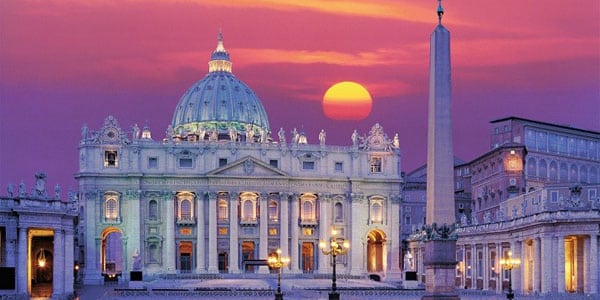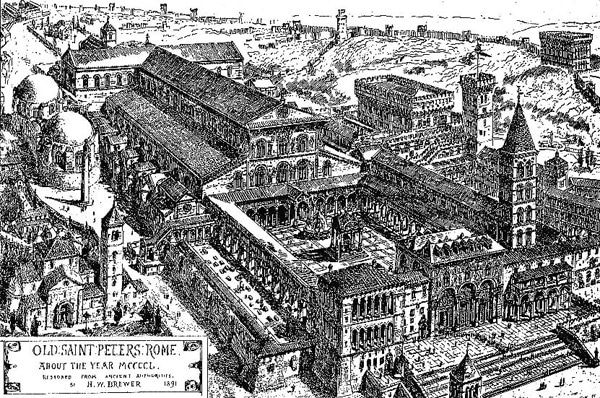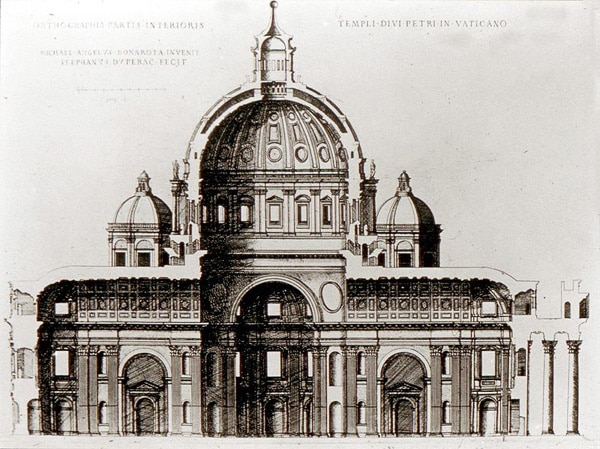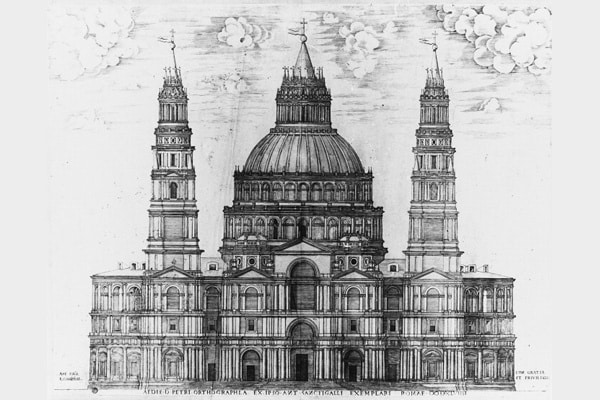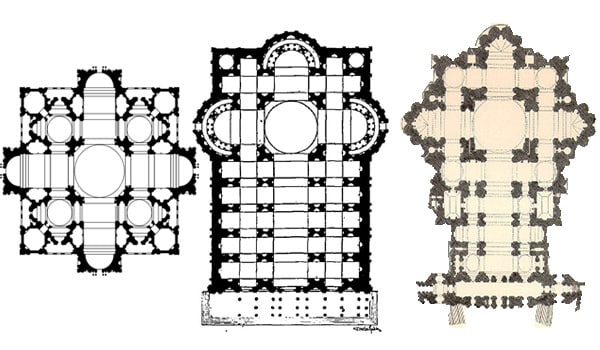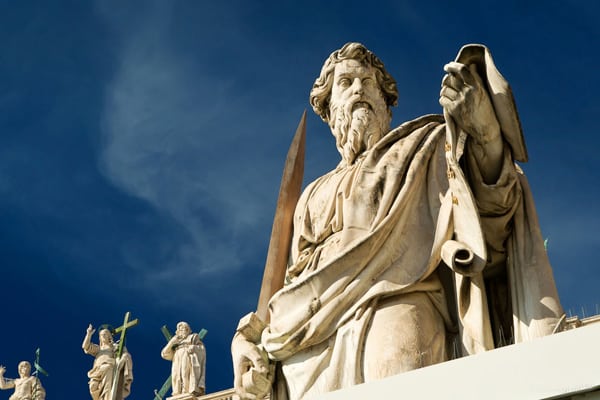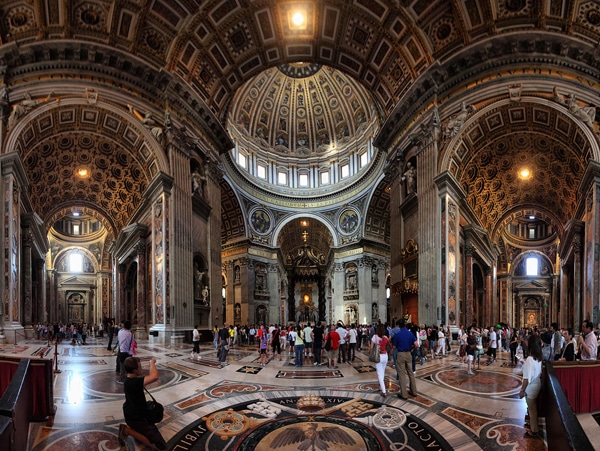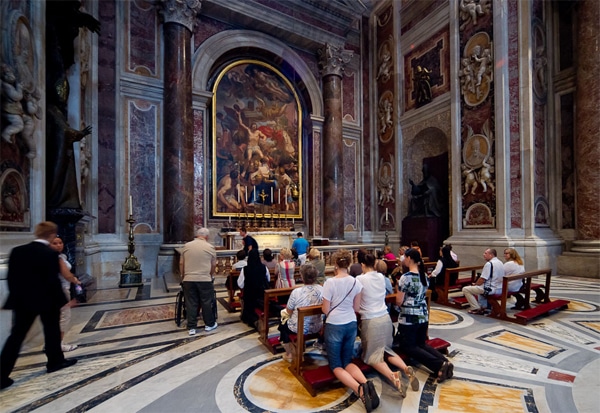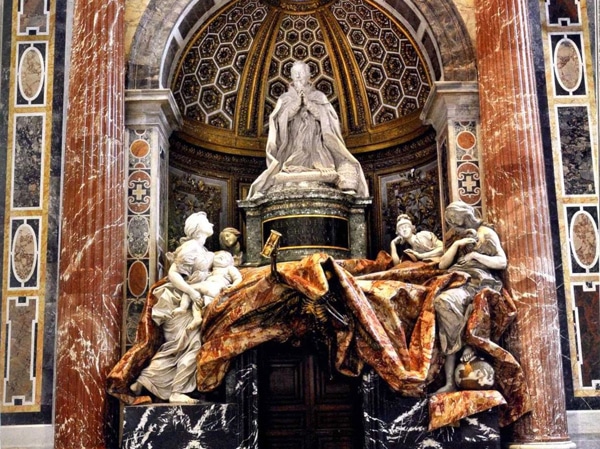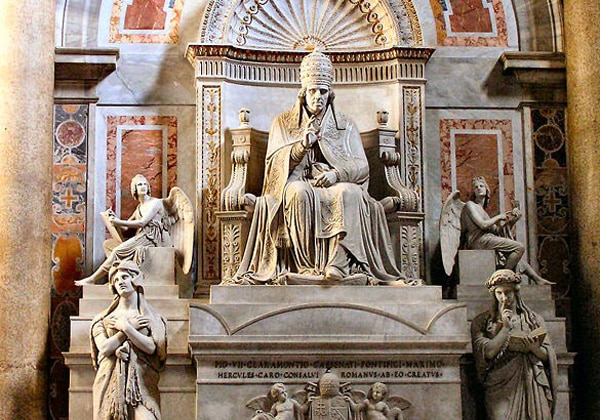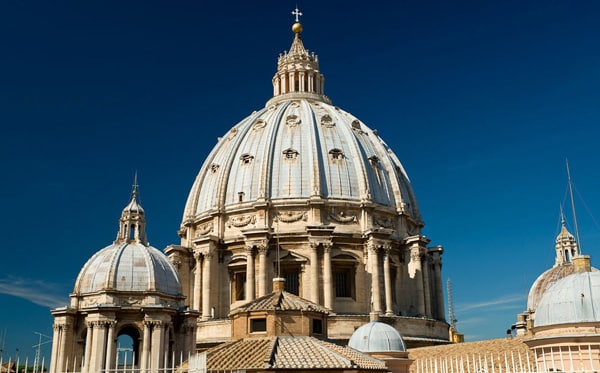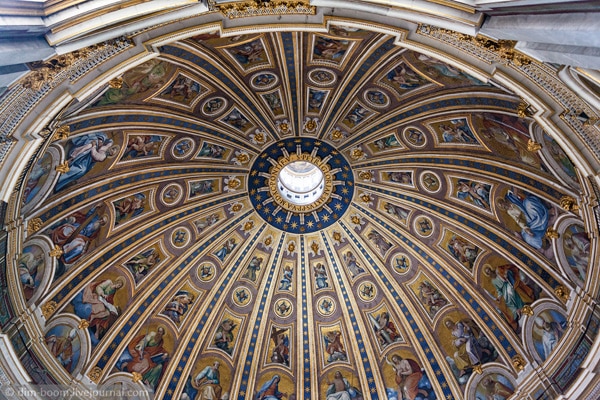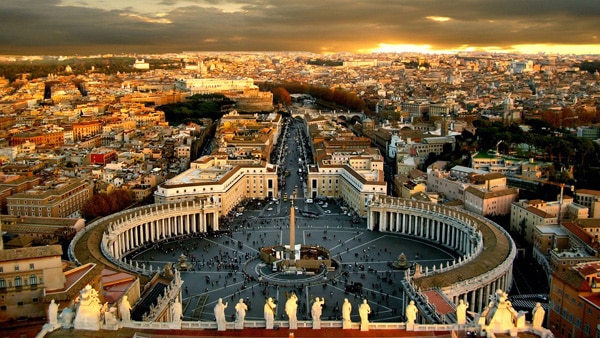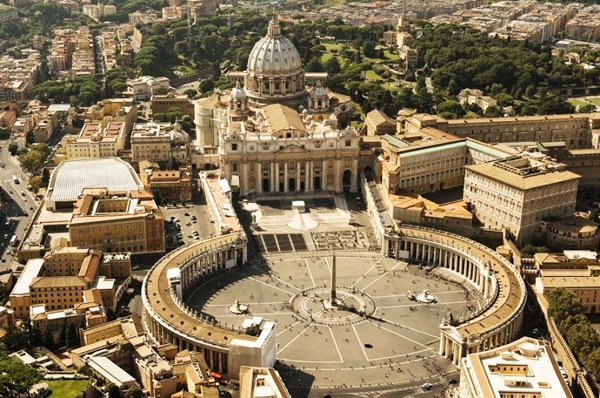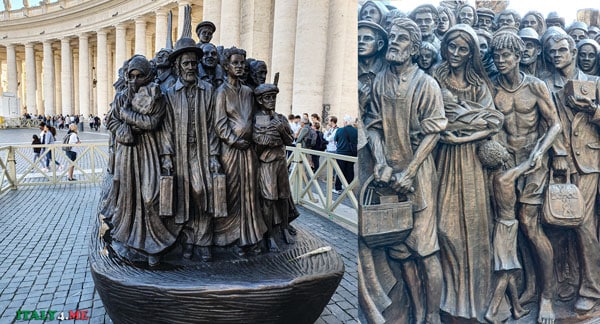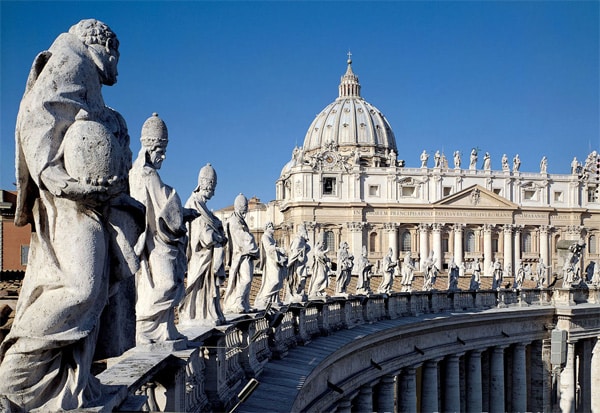St. Peter’s Basilica (Basilica di San Pietro) and the large colonnaded square are the religious center of the Vatican (Stato della Città del Vaticano).
The intricate Cathedral was built in the 17th century by the grandmasters of the High Renaissance and Baroque: Bernini, Michelangelo, Bramante, Raphael. Since then, the basilica has been the most significant Catholic church on the planet, attracting millions of parishioners annually to services conducted by the Pope himself.
Page Contents
History
In the 4th century A.D., under Emperor Constantine I (lat. Flavius Valerius Aurelius Constantinus), a Roman basilica was erected in Rome. Only the monument marking the center of St. Peter’s Square, located in front of the church, survived from the early Christian buildings.
According to Christian chronicles, the apostle Peter (Greek: Απόστολος Πέτρος) suffered martyrdom around 64-67 A.D. in Rome. Over the tomb of Christ’s follower, the first altar of the first basilica was erected in 313.
Constantine’s Basilica underwent several reconstructions and had significantly deteriorated by the 16th century. Pope Julius II (lat. Iulius II) tasked Donato Bramante with an intriguing challenge — to restore the ancient Christian church while preserving its original potential. The architect planned for the renovated basilica to represent a large cross crowned by a dome.
The spacious building with high vaults was intended to embody the heavenly lightness of the temple, but Bramante’s death in 1514 delayed the realization of the project indefinitely.
Even during Bramante’s lifetime, in 1513, Raphael Santi became the second architect of the church. He was assisted by Fra Giocondo, later replaced by Giuliano da Sangallo. The history of the church’s creation was clouded by a remarkable fact: three renowned masters died within six years of working on the project. Since 1506, St. Peter’s Cathedral had only its foundation and partially the lower wall tier, which was later dismantled.
For 40 years, the designs of St. Peter’s Cathedral transformed on paper, changing the shape of the building from a Greek equilateral cross to a Latin cross, and finally settling on the basilica form proposed by Antonio da Sangallo (Antonio da Sangallo). In 1546, da Sangallo died, and Pope Paul III engaged
Michelangelo to oversee the temple’s construction. Considering the accumulation of architectural ideas from his predecessors, Buonarroti returned to Bramante’s original plan, simultaneously simplifying and reinforcing the structure.
The mass of the basilica was decided to be executed as a central dome structure, with an entrance hidden by a portico draped with columns, following the example of ancient temples. Also, following the tradition of ancient builders, the temple’s central entrance was located on the eastern side.
During Michelangelo’s lifetime, construction made significant progress, including constructing the dome’s drum.
However, the genius could not complete his grand project; Michelangelo’s work was interrupted by his death in 1564.
Giacomo della Porta continued the construction of the Cathedral, making his adjustments to Michelangelo’s plan. Elements of the protobarocco style appeared, with more elongated forms, especially noticeable in the drawings of the dome’s drum. Buonarroti’s concepts were realized in their pure form only during the construction of the western part of the church.
By 1588, della Porta, in collaboration with Domenico Fontana (Domenico Fontana), implemented the plan for preparatory work for constructing the dome of St. Peter’s Cathedral. In the subsequent 2 years, all efforts of engineers and builders were focused on creating the main vault of the temple. By May 1590, Pope Sixtus V held a solemn mass in the newly built Cathedral.
During the summer, a colonnade of 36 decorative columns was built, however, Sixtus V did not live to see the exterior decoration of the church, passing away in August 1590. The golden lantern in the shape of a sphere and a large cross above the church’s dome were installed during the time of Clement VIII (lat. Clemente VIII).
The next phase of construction of St. Peter’s Cathedral was inspired by Pope Paul V (Paulus V). In 1605, he called upon Carlo Maderno (Carlo Maderno) to revise the Cathedral’s plan.
The Greek cross, in the form of the building as envisioned by Michelangelo, was transformed into a Latin cross by extending the longitudinal part.
Side aisles were also added, thus transforming the temple into a three-nave basilica. The updated church acquired a completely different look from Michelangelo’s original concept – standing today at the center of the square near the obelisk, you can only see part of the dome, but approaching closer to the Cathedral, it may seem more like a palace than a church.
Description
St. Peter’s Cathedral is impressive: about 211 meters in length and, including the dome, 132 meters in height, with a total area of 23,000 square meters.
Such impressive dimensions allow it to far surpass its closest competitors. Markers indicating the sizes of other Catholic churches are placed on the floor so visitors can appreciate the monumental scale of the building.
Facade
The modern facade of the Cathedral was completed by architect Carlo Maderno in the 17th century. Clad in travertine, the Baroque facade is solid in dimensions — 118 meters in width and 48 meters in height.
Classical columns support an attic crowned with 13 statues. A five-meter statue of Christ, surrounded by John the Baptist and 11 apostles, adorns the front of St. Peter’s Cathedral. The temple’s facade is also decorated with clocks created in the 18th century by Giuseppe Valadier.
Behind the columns of the portico, five gates lead inside the Cathedral: the Door of Death (Porta della Morte), the Door of Good and Evil (Porta del Bene del Male), the Filarete Door (Porta del Filarete), the Door of the Sacraments (Porta dei Sacramenti), and the Holy Door (Porta Santa). The most notable is the Door of Death, created in the mid-20th century by sculptor Giacomo Manzu. Through these doors, the Vatican sends off its pontiffs on their final journey.
The central portal of the Cathedral is adorned with two equestrian statues: Charlemagne, made in the 18th century by Agostino Cornacchini, and Emperor Constantine, a work by Bernini (1670). Another gem of the temple’s exterior is the fresco “Navicella” (Navicella degli Apostoli), by Giotto di Bondone, created in the 13th century.
Interior
St. Peter’s Cathedral boasts an impressive interior space, divided between three naves. Arch vaults, 23 meters high and about 13 meters wide, separate the central nave from the side. A gallery, 90 meters long and covering about 2,500 square meters, starts at the temple’s entrance and leads to the altar. In the last arch of the central nave, there is a miraculous bronze statue of Saint Peter, to which thousands of pilgrims flock.
Through the Cathedral, the Vatican has become a repository of the most precious works of art, from the floor to the tip of the dome. The marble floors of the church partially retain elements of the earlier basilica, reconstructed in the 13th century.
The attention is drawn to the disk of red Egyptian porphyry, where Charlemagne knelt during his coronation in 800 AD, and most rulers of Europe until the 15th century.
Many elements of the interior decor were created with the involvement of Gian Lorenzo Bernini, who spent 50 years of his creative life decorating the Cathedral. One of his significant works is the statue of the Roman centurion Longinus. According to legend, the centurion, suffering from impoverished vision, pierced the crucified Christ to confirm the death of the Son of God. Christ’s blood splashed onto Longinus’ eyes, and he immediately regained his sight. Sometime later, Longinus converted to Christianity, actively preached, and is now revered as one of the leading Christian saints.
St. Peter’s Cathedral, as one of its relics, preserves the spearhead of the Roman centurion.
Above the church’s altar is another masterpiece by Bernini — a vast baldachin (ciborium) resting on four ornate pillars. The baldachin was created during the time of Urban VIII, and many decorative elements sing praises to the aristocratic family of the pontiff. The fabulous cost of the master’s work was covered by the treasury of the Barberini family. Still, the bronze and other building materials were shamelessly taken from the Pantheon (Greek πάνθειον).
To this day in Rome, there’s a saying: “What the barbarians didn’t do, the Berninis and Barberinis did.”
Above the baldachin rises the chair, which is dedicated to St. Peter and also created by Bernini.
Strolling through the central nave of the Cathedral, you can admire statues in the niches of saints: Teresa, Elena-Sofia Barat, Saint Vincent de Paul, John, Saint Philip Neri, Saint Jean-Baptiste de La Salle, Saint John Bosco.
Right Nave
Pietà
In the right nave of the Cathedral is the sculptural group “Pietà” (The Lamentation of Christ) by a young Michelangelo (created in 1499).
The statue is covered with a sturdy glass dome to protect this masterpiece from harmful temperature fluctuations, dust, humidity, and careless visitors. In 1972, a religious fanatic seriously damaged the masterpiece with a hammer!
Monument to Pope Leo XII
Next to the Pietà is the monument to Pope Leo XII by Giuseppe de Fabris (19th century) and the memorial to Christina, Princess of Sweden, created by Carlo Fontana in the 17th century.
Chapel of Saint Sebastian
In the Chapel of Saint Sebastian (Cappella di San Sebastiano), visitors can admire the mosaic by Pier Paolo Cristofari, based on sketches by Domenichino. The chapel’s vault is adorned with a mosaic by Pietro da Cortona.
Tomb of the Marquise Matilda of Canossa
A unique monument is the tomb of Marquise Matilda of Canossa, created by Bernini. She was the first woman buried in the temple.
Chapel of the Holy Sacrament
The Chapel of the Holy Sacrament (Cappella del Santissimo Sacramento) is decorated with a decorative grille, based on sketches by Francesco Borromini. Inside the chapel is the bronze work by Carlo Moderno, with architecture by Borromini.
Left Nave
Tomb of Alexander VII (Latin: Alexander VII)
Bernini’s last significant work adorns the tomb of Alexander VII from the Chigi family. The ensemble, made of colored marble and bronze, depicts the praying pontiff surrounded by allegorical statues of Mercy, Truth, Justice, and Prudence. In front of Alexander VII is a skeleton wrapped in a red cloak – a symbol of death.
In the skeleton’s hand are hourglasses – a metaphor for the end of the pontiff’s earthly life.
This Baroque ensemble is filled with theatrical drama and is full of hidden meaning. For instance, one of the virtues is depicted standing on a globe. Notably, the stone foot covers England, symbolizing the 17th-century schism between the Catholic and Anglican churches. The British monarchs from the Stuart line renounced the crown to remain faithful to the Catholic faith. Bernini artistically played with this controversial situation in stone. The Stuart Tomb is now inside the Cathedral to the left of the entrance.
Baptism Chapel
The left nave houses the Baptism Chapel (Cappella del Battesimo), designed by Carlo Fontana and adorned with mosaics by Baciccio. Nearby is the tomb of Maria Clementina Sobieski, decorated by the sculptor Pietro Bracci in the 18th century. Adjacent to it is the Stuart Memorial, by Antonio Canova (19th century). Notable is the work of the 15th-century Florentine architect Antonio Pollaiolo – the tomb of Pope Innocent VIII.
Center
The central space of the Cathedral, bounded by four pillars supporting the dome, was realized according to Michelangelo’s designs. In the heart of the church, numerous mosaic paintings are executed based on designs by Domenichino.
Particularly moving is the memorial to Pius VII, created in the 19th century by the non-Catholic artist Bertel Thorvaldsen. St. Peter’s Cathedral has the Gregorian Chapel (Gregoriana Cappella), which reminds us of who gave humanity the Gregorian calendar. The numerous tombs of the pontiffs and richly decorated chapels leave an indelible impression on the congregation.
The Dome
The Dome of St. Peter’s Cathedral is a magnificent work of art. Its maximum height is 133.3 meters from ground level, with an interior height of 117.57 meters, an inner diameter of 41.5 meters, and a total weight of 14,000 tons! The dome image has been an emblem of the Cathedral and one of the most recognized symbols of the Vatican for centuries.
Michelangelo, who created the architectural plan of the dome, was inspired by the Pantheon and the Santa Maria del Fiore (La Cattedrale di Santa Maria del Fiore) in Florence.
The high drum of the dome ensures stability for the massive structure. It features 16 windows separated by columns and precisely 16 reinforcing ribs. Inside, the structure’s stability is supported by four massive pillars.
The Cathedral houses models and sketches of the dome as envisioned for construction by Michelangelo, Sangallo, and Bramante. All had a more rounded form, aiming for the parameters of an ideal sphere. However, the dome’s construction was entrusted to Giacomo della Porta, who implemented a slightly different model. Changes were made to provide excellent reliability and stability to the dome, especially considering the structure was 7 meters higher than initially planned.
Despite all the architects’ and builders’ efforts, by the 18th century, the dome began to crumble under its weight and the impact of the winds. Four sturdy chains were used to tie the vault, adding additional rigidity. The dome’s interior is adorned with mosaic paintings by Giovanni De Vecchi.
Michelangelo’s dome was realized according to the master’s sketches: a sphere ascending skyward, decorated with coffered decor.
Tomb of Saint Peter
In 1939, under the orders of Benito Mussolini, extensive archaeological research was conducted beneath the floors of the Cathedral, leading to the discovery of an ancient necropolis. One of the tombs in this necropolis held special significance. It was determined that in the 1st and 2nd centuries A.D., one of the graves was particularly venerated.
A thorough examination of church chronicles and repeated excavations led to the high probability that the tomb of the Apostle Peter rests under St. Peter’s Cathedral, a fact solemnly announced by Pope Paul VI in 1968.
St. Peter’s Square (Piazza San Pietro)
The majestic 16th-century Cathedral required a fitting frame. The Vatican decided the poorly planned rectangular space at the Cathedral’s foot needed to be elegantly shaped. Moreover, a path from the Apostolic Palace (Palazzi Apostolici) to the basilica was needed.
Gian Lorenzo Bernini created St. Peter’s Square over 11 years, beginning construction in 1656.
Bernini’s architectural plan had two major elements: the oval plane of the square itself, surrounded by semi-circular galleries, and trapezoidal avenues leading to the square and Cathedral.
From a bird’s-eye view, the square, avenue, and Cathedral resemble a key, hence the name “Key of Saint Peter.” The oval of the square rests in a basin formed by two galleries, each equipped with columns. The colonnade of 284 Doric columns and 80 travertine pillars is crowned with an attic, adorned with 140 statues of saints and several church coats of arms. On major Catholic holidays, St. Peter’s Square can accommodate approximately 400,000 visitors!
On September 29, 2019, Pope Francis unveiled a monument dedicated to all migrants and refugees at the left colonnade, affirming the necessity for no one to be excluded from society, whether a permanent citizen or a newcomer.
Interesting Facts
- There are 2 geometric centers on the cathedral square from which all 4 rows of columns hide behind each other.
- Legend has it that Julius Caesar’s ashes were stored atop the obelisk, but when it was moved in the 16th century, it turned out to be empty.
- The Italian police can enter the Cathedral only by special invitation.
- Bernini got the idea to build part of the square in a trapezoid shape from Michelangelo.
- For over 1000 years, the Vatican and St. Peter’s Cathedral were not considered the center of Christianity – the popes moved there only in the 15th century from the Lateran Basilica.
- Traditionally, no building in Rome can be higher than the dome of St. Peter’s Cathedral.
Practical Information
- Address: Piazza San Pietro
- Opening hours: summer period (from April 1 to September 30) — from 07:00 to 19:00, winter period (from October 1 to March 31) — from 07:00 to 18:30.
- Dome visit: summer period (from April 1 to September 30) — from 08:00 to 18:00, winter (from October 1 to March 31) — from 07:00 to 18:00.
- Ticket price: full walking ascent (551 steps) — 8 euros, lift + walking ascent (320 steps) — 10 euros, free for children under 12.
- Tours: www.getyourguide.com
- Visiting the tomb of St. Peter and the necropolis under the Cathedral : allowed after booking in advance by mail: scavi@fsp.va or by phone: +39 06 69873017. Individual ticket price – 13 euros. Working hours: Mon-Fri: from 09:00 to 18:00, Sat — 09:00 to 17:00.
- Official Vatican website: www.vatican.va
For visiting the Cathedral, dome, and archaeological excavations, a dress code is required: long skirts and trousers, covered shoulders, headwear, comfortable shoes.
How to Get There
Read the article on how to get to the Vatican for more details:
- By metro: Line A, Ottaviano station (closer to the museums).
- By tram: No. 19, San Pietro stop, about 200 meters from the Cathedral.
- By bus: No. 23, 32, 81, 590, 982, N11, stop at Risorgimento; No. 64 and 40 express routes from Termini Station (Termini) to St. Peter’s Cathedral; No. 116, stop at Terminal Gianicolo.
- By regional train: Roma San Pietro station (closer to the square), the train departs from Roma Trastevere station, ticket cost 1 euro.
 Italy for me From Italy with love
Italy for me From Italy with love

